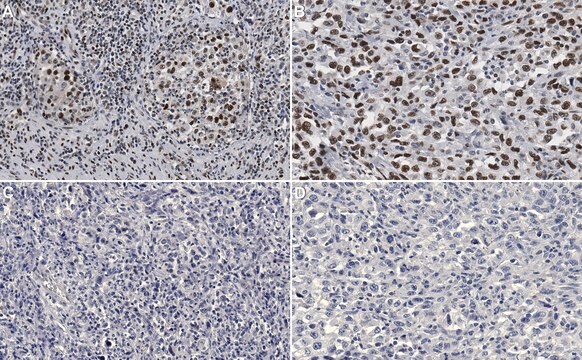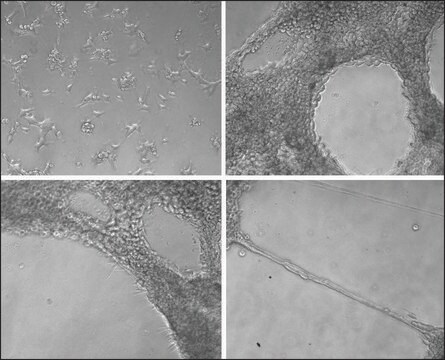06-863
Anti-CREB Antibody
Upstate®, from rabbit
Synonym(s):
Cyclic AMP-responsive element-binding protein 1, cAMP-responsive element-binding protein 1, CREB-1
About This Item
Recommended Products
biological source
rabbit
Quality Level
antibody form
purified immunoglobulin
antibody product type
primary antibodies
clone
polyclonal
purified by
using Protein A
species reactivity
mouse, human, rat
species reactivity (predicted by homology)
porcine (based on 100% sequence homology), horse (based on 100% sequence homology), canine (based on 100% sequence homology)
manufacturer/tradename
Upstate®
technique(s)
ChIP: suitable (ChIP-seq)
electrophoretic mobility shift assay: suitable
immunoprecipitation (IP): suitable
western blot: suitable
isotype
IgG
NCBI accession no.
UniProt accession no.
shipped in
dry ice
target post-translational modification
unmodified
Gene Information
human ... CREB1(1385)
General description
Specificity
Immunogen
Application
Chromatin Immunoprecipitation (ChIP) Analysis: A representative lot detected an enhanced CREB occupancy at the LYPD3 promoter in LKB1-deficient TE-4 human esophageal cancer cells (Gu, Y., et al. (2012). Oncogene. 31(4):469–479).
Chromatin Immunoprecipitation (ChIP) Analysis: A representative lot detected CREB association at the RNASET2 sites targeted by T-cell Leukemia Virus type 1 (HTLV-1) encoded Tax protein using HTLV-1-infected human T-cell lines, MT-2, C8166/45 and SLB-1 (Polakowski, N., et al. (2011). Viruses. 3(8):1485-500).
Chromatin Immunoprecipitation (ChIP) Analysis: A representative lot detected CREB occupancy at the hBDNF promoter IV using postmortem human parietal cortex tissue chromatin preparations (Pruunsild, P., et al. (2011). J. Neurosci. 31(9):3295-3308).
Chromatin Immunoprecipitation (ChIP) Analysis: A representative lot detected CREB occupancy at the miR-9-2 promoter in SK-N-BE human neuroblastoma cells (Laneve, P., et al. (2010). Nucl. Acids Res. 38(20):6895-6905).
ChIP-seq Analysis: A representative lot identified CREB target genes in murine spermatogonia derived GC1-spg cells by ChIP-seq analysis (Martianov, I., et al. (2010). BMC Genomics. 11:530).
Western Blotting Analysis: Representative lots detected CREB in lysates from cultured embryonic rat striatal neurons and PC12 pheochromocytoma cells (Hutchinson, A.N., et al. (2012). Neuropsychopharmacology. 37(2):321-337; Maharjan, S., et al. (2010). J. Neurochem. 112(1):42-55).
Western Blotting Analysis: Representative lots detected CREB in mouse proximal caput epididymis-1 (PC-1) cell lysate and hippocampus tissue homogenates (Hamzeh, M., and Robaire, B. (2011). J. Endocrinol. 209(1):55-64; Zhou, Z., et al. (2009). Neuropharmacology. 56(1):81-89).
Western Blotting Analysis: A representative lot detected CREB in SK-N-BE human neuroblastoma cell lysate (Laneve, P., et al. (2010). Nucl. Acids Res. 38(20):6895-6905).
Electrophoretic Mobility Shift Assay (EMSA): A representative lot caused a supershift of DNA-CREB complex in EMSA using radiolabeled oligonucleotide containing hBDNF promoter I CREB-binding sequence and lysates from KCl-treated primary rat neurons (Pruunsild, P., et al. (2011). J. Neurosci. 31(9):3295-3308).
Epigenetics & Nuclear Function
Transcription Factors
Quality
Western Blotting Analysis: 0.5 µg/mL of this antibody detected CREB in 10 µg of HeLa nuclear extract.
Target description
Linkage
Physical form
Storage and Stability
Handling Recommendations: Upon receipt and prior to removing the cap, centrifuge the vial and gently mix the solution. Aliquot into microcentrifuge tubes and store at -20°C. Avoid repeated freeze/thaw cycles, which may damage IgG and affect product performance.
Note: Variability in freezer temperatures below -20°C may cause glycerol containing solutions to become frozen during storage.
Analysis Note
Positive Antigen Control: Catalog #12-309, Hela cell nuclear extract. Add an equal volume of Laemmli reducing sample buffer to 10 μL of extract and boil for 5 minutes to reduce the preparation. Load 20 μg of reduced extract per lane for minigels.
Other Notes
Legal Information
Disclaimer
Not finding the right product?
Try our Product Selector Tool.
Storage Class Code
10 - Combustible liquids
WGK
WGK 1
Certificates of Analysis (COA)
Search for Certificates of Analysis (COA) by entering the products Lot/Batch Number. Lot and Batch Numbers can be found on a product’s label following the words ‘Lot’ or ‘Batch’.
Already Own This Product?
Find documentation for the products that you have recently purchased in the Document Library.
Our team of scientists has experience in all areas of research including Life Science, Material Science, Chemical Synthesis, Chromatography, Analytical and many others.
Contact Technical Service







